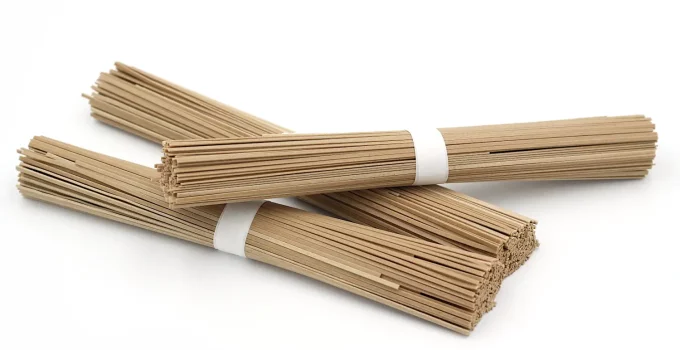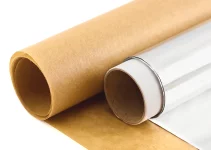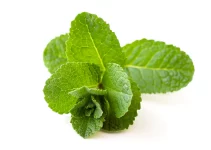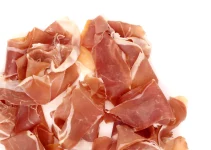Which are the best options as substitutes for soba noodles? That’s what we’re here to figure out. Whether it’s because you don’t like their taste or because you can’t find them where you live, there are plenty of replacements to choose from.
Let’s quickly sum up the best soba noodles substitutes and then we’ll talk about each in part:
- ramen noodles
- udon
- spaghetti, preferably whole wheat spaghetti
- somen noodles
- rice noodles
- naengmyeon (Korean buckwheat noodles)
- Chinese buckwheat noodles
- Chinese noodles (made from wheat flour)
- kelp noodles
- zucchini noodles
Check out my recommendations for the spiciest instant ramen noodles if you’re in the mood for some food that can set you on fire, make you sweat, and as happy as we can be.
Table of Contents
Top 10 Substitutes for Soba Noodles
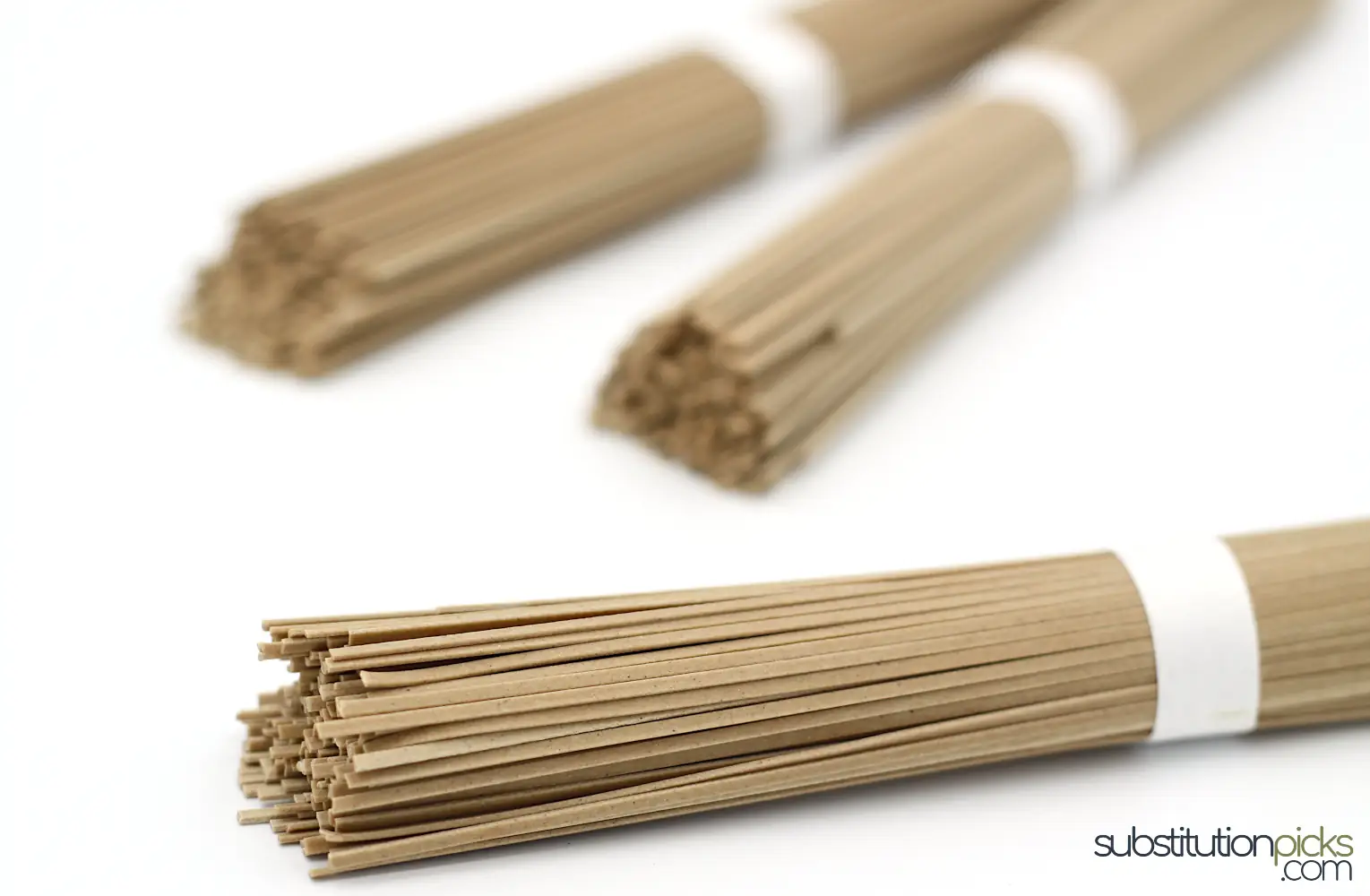
Let’s see how each of these substitutes differ from soba so that you know which would be best for your dishes.
I should also tell you that most Asian noodles are in fact Chinese noodles that have been imported from China to Japan or to other Asian countries more than a few hundred years ago. I wasn’t aware of that history so it was nice to read more about it as I researched all these various types.
However, soba and udon are strictly Japanese. Soba is Japanese for buckwheat.
Tempura is my favorite food to serve with soda noodles. Check out my reviews for the best tempura fryer if you want to make this delicious dish. It’s also served on rice.
1. Ramen noodles
Some might confuse ramen and soba but they’re totally different types of noodles. Soba are the brown or gray ones, in case you need a marker to easily identify them by.
Soba is a staple in Japanese food, as famous as miso, tempura, and sushi.
Ramen is Chinese. According to kizuki.com, ramen noodles were actually called Chinese soba. Still, Japan actually made them famous, more famous around the globe than even soba.
What they have in common is that they’re both thin. That’s why I decided to recommend ramen as one of the best substitutes for soba noodles.
And you’ll find them a lot more easily in many places on the planet.
I imagine that there are very few countries who don’t have ramen noodles for a very affordable price.
Just be aware that they have more calories and less nutrients than soba.
Plus, in my opinion, soba remains the champion when it comes to tasty noodles.
2. Udon
Soba and udon are staples in Japanese cooking. But they’re also completely different. Popularity one major thing they have in common. And the fact that they’re interchangeable.
Udon are white, very thick, with a chewy texture. Simply put, these are thick wheat noodles. They can be round, square or flat although we’re mostly used to seeing the round-shaped ones.
Until soba gained in popularity, udon was the mainstay of Japanese pasta.
Unlike udon, which has a mild flavor but an awesome texture, soba has a slightly nutty taste. That’s the main reason why soba is often used in simple, light dishes that don’t rely on rich flavors.
Even so, udon are wonderful substitutes for soba noodles. They’re interchangeable in most recipes.
3. Spaghetti (whole wheat spaghetti)
If you’re unable to get your hands on any Asian noodles, there’s no other solution than to turn to the classic European pasta: spaghetti.
Spaghetti can work as substitutes for soba noodles.
If you’re aiming for more nutrients and fewer calories, go for whole wheat spaghetti. Whole wheat flour has fewer calories than white whole wheat flour.
If you like more texture in your noodle dishes, go for thick spaghetti, which is also known as spaghettoni.
4. Somen
Somen are very thin East Asian noodles made of wheat flour. They’re similar in texture to ramen but much thinner. They’re as thin as vermicelli, very delicate.
I will be honest and say that it’s not my favorite soba substitute because they are just too thin. The size difference is pretty substantial in this case.
If I were to say, somen are good substitutes for vermicelli but that’s about it.
I will admit that eating them dipped in soy sauce and dashi is a delight. They’re served cold and their firm texture is very refreshing. Plus, not much prep is needed for such simple delicacies.
5. Rice noodles (gluten-free substitute for soba noodles)
If you’re looking for a gluten-free substitute for soba noodles, rice noodles might be some of the easiest to find.
They’re usually just made from rice flour and water.
Their price is pretty good, too.
The thing with rice noodles is that they can be either round or flat and have different thicknesses.
Choose the ones you can find wherever you live and use them as substitutes for soba noodles.
They’re very versatile so they work very well as replacements for many other types of noodles. What I like about rice noodles is that they have a mild flavor and they’ll take the flavor of the ingredients they’re combined with.
Wide rice noodles are some of the most popular Thai specialties.
The thing to remember is that if they’re left long in hot water they’ll get mushy very quickly.
6. Naengmyeon (Korean buckwheat noodles)
I didn’t mention these ones first because I imagine that if you can’t find soba you won’t be able to find naengmyeon either.
Naengmyeon is the name for Korean buckwheat noodles. This is Korea’s counterpart to Japanese soba. The difference is that naengmyeon are slightly chewier. They’re very popular in their country of origin.
They’re usually made from buckwheat flour and potato starch.
They can be served cold in a savory broth with different toppings like vegetables and fish.
Some packages are even sold with a soup base.
7. Chinese buckwheat noodles
The Chinese also have their own version, simply known as Chinese buckwheat noodles.
As the name suggests, these too are also made from buckwheat flour, like it’s the case with soba and naengmyeon.
8. Chinese noodles
If we’re simply calling them by the name Chinese noodles, that means that they’re made from wheat flour.
Thus, these two Chinese noodles types are different, based on the type of flour they’re made from.
Actually, to make yakisoba, Chinese noodles made from wheat flour are used instead of soba. Of course, we can also make them with soba.
We could say that soba noodles and Chinese noodles can be used interchangeably, although they look completely different.
On the packaging, things like Chow Mein Stir-Fry Noodles or Chinese Style Lo Mein Noodles might also be written.
9. Kelp noodles
Kelp is a sea vegetable. For some that might not sound all that exciting but I think it is.
Thus, a sea vegetable is transformed into interesting noodles.
Moreover, kelp Noodles are fat-free, gluten-free and very low in carbohydrates and calories.
Another good news is that even if they’re made from a sea vegetable, they’re quite neutral-tasting.
Some kelp noodles require no cooking. They can be served right from the package. Others will need to be boiled. You should read the instructions that are written on the packaging to figure out how to prepare them.
If they require no cooking time, you should still rinse them in water before adding them to the rest of the ingredients. Otherwise, they’re too salty. You’ll have to pull them apart with your fingers.
Other instructions might have you soaking them in cold water with baking soda and lemon juice until the desired texture and firmness is achieved, then rinse and strain. They’re different methods to prepare them, that’s why you should follow the instructions.
10. Zucchini noodles
Would I actually use zucchini noodles as substitutes for soba noodles? Well, no, I wouldn’t.
These two types of noodles are so far apart, there are oceans between them. It’s not that I don’t like zucchini noodles, it’s more like I am more traditional when it comes to some of my favorite dishes.
If I don’t have soba, I will at least use ramen. Ramen remains the most logical choice for me when it comes to substitutes for soba noodles.
Fortunately, if you aren’t concerned about traditions like I am, you might definitely enjoy some zucchini noodles.
The other good news is that zucchini noodles don’t have a strong flavor. It’s why we can even make zucchini and carrot cake. This is a highly versatile fruit/vegetable.
Zucchini noodles don’t contribute a specific taste to a recipe because they don’t have much flavor. Instead, they absorb the flavors of the other ingredients. And that’s why I mentioned them as substitutes for other types of noodles.
It’s a perfect substitute for those who only want to eat vegetables and nothing else.
Well, the bad news is that you need a vegetable spiralizer to make them if this is your desired substitute. There’s no other way. The good news is that, once you have the vegetable spiralizer, you’ll be able to enjoy some awesome noodles whenever the mood strikes you.
You’ll also be eating much less calories. Zucchinis are 90% water so that’s another plus.
What Are Soba Noodles?
In order to better understand which soba noodles substitutes work best for the dish you’re making, it would be nice to know exactly what you’re trying to substitute. That way, things will become more clear.
Soba is a thin Japanese noodle that’s made from a mix of buckwheat flour and wheat flour. They’re commonly known as buckwheat noodles.
Soba is easily recognizable. If you’ve seen them once, their image will stick with you.
That’s because these thin noodles have a distinctive brown or gray color.
Ramen and udon have a white color because they’re made with only wheat flour (white bread flour).
On the other hand, buckwheat is not even a grain, it’s not a type of wheat. It’s regarded as a grain because it has the same culinary uses as the other grains. One example of that culinary use is that it’s used to make these noodles.
What you need to make soba
Besides buckwheat and wheat flours, water is the only other ingredient needed to make them. You could give it a try at home, if you’re the kind who makes his/her own pasta.
You just need to buy buckwheat and whole wheat flours. Buckwheat has become more and more popular around the globe. The flour is darker in color than bread flour but I think that it’s beautiful.
You can substitute the wheat flour with all purpose flour.
The equipment needed is: cutting board, rolling pin, sharp broad knife, plastic wrap, and large mixing bowl.
How to substitute soba noodles
We can draw 2 conclusions from this short introduction to soba: in terms of thinness, the best substitute for soba noodles would be ramen.
Soba works for both cold and hot dishes. Thus, if you are looking for a replacement for ramen, you can use soba. These substitutions go both ways.
If you only have udon, that works too. However, you should take into account that they are thicker and chewier.
Or you can use whole wheat spaghetti as a substitute for soba noodles if you live in a place that has no imported Asian products.
On the other hand, the reverse can happen. If you want to eat fewer calories, you can substitute soba noodles for regular spaghetti.
Best Soba Noodles to Buy
If you are convinced that you should rather focus on buying the best soba instead of using substitutes for soba noodles, let’s see which are our top options.
The price of soba noodles is determined by 2 factors:
- they’re more expensive if they’re hand-made – these are also known as te’uchi soba
- the more buckwheat is used the better they are, which is another factor that makes them more expensive – 40% buckwheat flour content is a good choice
If you’re on a gluten-free diet, you need to make sure that they are 100% made of buckwheat or from a combination of buckwheat and other gluten-free flours.
Buckwheat is gluten-free but most soba are made from a mix of buckwheat and whole wheat flours.
The good news is that those that are gluten free state that on the packaging, you won’t have to guess.
1. Hakubaku Organic Soba
These are organic but they’re not 100% buckwheat so they’re not gluten free.
The ingredients are: organic wheat flour, organic buckwheat flour, and water.
The way you prepare them is in rapid boiling water for 4 minutes, no salt or oil is needed.
2. King Soba 100% Buckwheat Organic Noodles
If you’re looking for 100% buckwheat noodles, these are a very nice option.
Since they’re only made of buckwheat flour, they’re also gluten-free. Plus, they’re organic.
They’re also quite expensive. But they can be worth a try if you have the budget for it and you really want 100% buckwheat. The only other ingredient is water.
When you’re preparing them, read the instructions carefully.
It says that you should bring the water to a boil, submerge the soba in water, then reduce to medium heat and separate gently with a fork. Cook only for 3-4 minutes, stirring occasionally. Not more than that. Immediately drain them in a colander and rinse well with cold water.
3. Hime Buckwheat Soba Noodles
The major thing that you should know if you’re checking out these soba is that they are sold in a large quantity. And the price is quite good. They’re not very expensive, given the quantity.
Each pack weighs 25.40 oz (720g). That’s a lot of noodles. Moreover, you can get a twin pack, which means getting 1.58 pounds. You’ll be cooking a lot of dishes.
They are not 100% buckwheat nor gluten-free nor organic.
The ingredients are: wheat flour, buckwheat flour, water, salt. They definitely taste like soba noodles and they’re delicious. An awesome choice.
They’re produced in Japan and made from premium buckwheat grown in Japan.
You can buy soba like these ones that I mentioned or you can try any of the above substitutes for soba noodles, just read the instructions on how to prepare whatever type you buy and you’re good.

